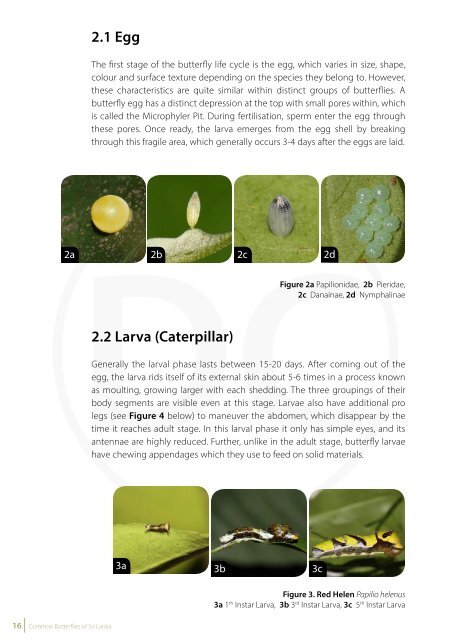Common Butterflies of Sri Lanka
Common Butterflies of Sri Lanka
Common Butterflies of Sri Lanka
You also want an ePaper? Increase the reach of your titles
YUMPU automatically turns print PDFs into web optimized ePapers that Google loves.
2.1 Egg<br />
The first stage <strong>of</strong> the butterfly life cycle is the egg, which varies in size, shape,<br />
colour and surface texture depending on the species they belong to. However,<br />
these characteristics are quite similar within distinct groups <strong>of</strong> butterflies. A<br />
butterfly egg has a distinct depression at the top with small pores within, which<br />
is called the Microphyler Pit. During fertilisation, sperm enter the egg through<br />
these pores. Once ready, the larva emerges from the egg shell by breaking<br />
through this fragile area, which generally occurs 3-4 days after the eggs are laid.<br />
Meso throrax<br />
Pro throrax<br />
Head<br />
Thorax<br />
Simple eyes 3<br />
2<br />
1<br />
Meta throrax<br />
Abdomen<br />
4 5 6 7 8 9<br />
10<br />
11<br />
12<br />
13<br />
Antenna<br />
Mandible<br />
Thoracic<br />
legs<br />
Spiracles<br />
Pro legs<br />
Pro leg<br />
Anus<br />
14<br />
2a<br />
2b 2c 2d<br />
Figure 4 structure <strong>of</strong> the larva<br />
2.2 Larva (Caterpillar)<br />
Figure 2a Papilionidae, 2b Pieridae,<br />
2c Danainae, 2d Nymphalinae<br />
Generally the larval phase lasts between 15-20 days. After coming out <strong>of</strong> the<br />
egg, the larva rids itself <strong>of</strong> its external skin about 5-6 times in a process known<br />
as moulting, growing larger with each shedding. The three groupings <strong>of</strong> their<br />
body segments are visible even at this stage. Larvae also have additional pro<br />
legs (see Figure 4 below) to maneuver the abdomen, which disappear by the<br />
time it reaches adult stage. In this larval phase it only has simple eyes, and its<br />
antennae are highly reduced. Further, unlike in the adult stage, butterfly larvae<br />
have chewing appendages which they use to feed on solid materials.<br />
2.2.1 Food<br />
The first meal <strong>of</strong> the larva is its own egg shell which contains very high<br />
nutritional value including calcium and protein. Large butterfly larvae (e.g.<br />
Family Papilionidae) devour the whole egg shell, while small butterfly larvae (e.g.<br />
Family Lycaenidae) only partially eat the shell. Some species also consume their<br />
moulted external skin.<br />
Larvae obtain most <strong>of</strong> their food from plant materials, except for a few carnivorous<br />
species such as the Ape Fly (Spalgis epeus). Butterfly larvae only feed on specific<br />
plants which contain the the nutritional and chemical components required for<br />
their growth and survival. Such species-specific plants are called ‘butterfly larval<br />
food plants’ (LFPs). Most butterfly larvae feed on immature leaves, but some feed<br />
on mature leaves, flowers, flower buds, fruits, seeds and aerial roots.<br />
Some species are able to take up toxins into their bodies from these materials<br />
and retain them throughout their life cycle as a protection mechanism as these<br />
toxins make them unpalatable to predators. This is seen among species such as<br />
the Glassy Tiger (Parantica aglea) and the <strong>Common</strong> Rose (Pachliopta aristolochiae).<br />
3a 3b 3c<br />
Figure 3. Red Helen Papilio helenus<br />
3a 1 th Instar Larva, 3b 3 rd Instar Larva, 3c 5 th Instar Larva<br />
16 <strong>Common</strong> <strong>Butterflies</strong> <strong>of</strong> <strong>Sri</strong> <strong>Lanka</strong><br />
<strong>Common</strong> <strong>Butterflies</strong> <strong>of</strong> <strong>Sri</strong> <strong>Lanka</strong> 17















